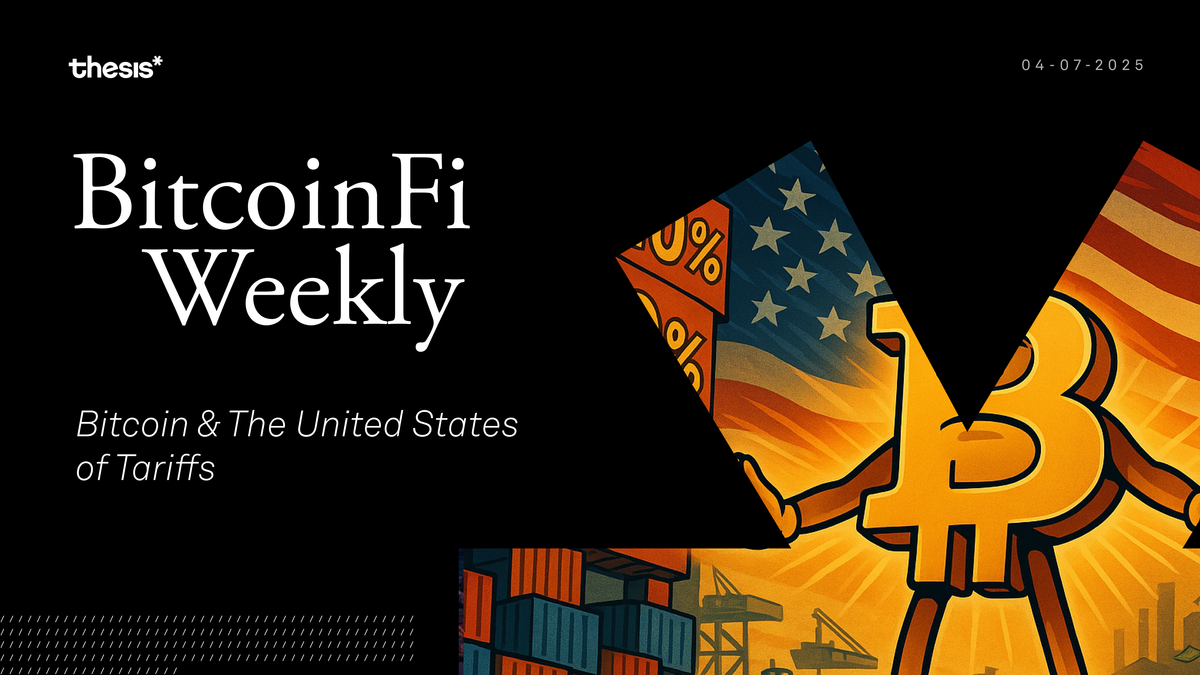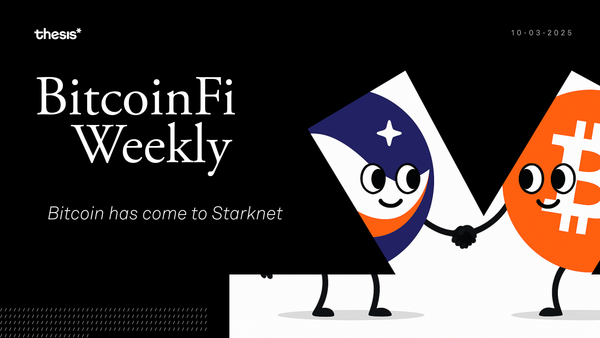Bitcoin & The United States of Tariffs
Bitcoin is tariff-proof in design. It doesn’t route through ports, doesn’t care about import math. It’s not made in China or taxed in euros. But if your bleeding from bonds, equities, and EM currency trades, BTC is probably the last thing you’re cutting.

Welcome to BitcoinFi Weekly. We cover where people use their BTC and what is changing in the Bitcoin world.
The world, it seems, has gone schizoid. Everywhere, the scaffolding of normalcy trembles: policy by press release, market moves like knife twitches, and central banks with their flinching credibility. And still the façade holds. Just barely. The hum of the machines running the show. Slowly but surely, you can hear these old world debt engines, synthetic credit scaffolds, and dollar diplomacy all starting to screech. Whether you dub it rebalancing, revenge or the redistribution of trade karma, make no mistake: this is how systems begin to shed their skin. Bitcoin was built for this. This edition we explore what that means, and more.
Here’s this week’s rundown:
🛃 Feature Piece: Bitcoin & The United States of Tariffs
🍋 Stack Sats on Solana with Lemon Drop
🎵 2.8M Sats for a Musical Inscription
⚙️ BRC2.0 Live on Signet
🧠 CoreWeave IPO: A Case Study for Mining Companies
Feature Piece: Bitcoin & The United States of Tariffs
President Trump's "Liberation Day" tariffs hit like a hammer. These tariffs echo Smoot-Hawley of 1930, an alarming parallel given how those earlier tariffs worsened the Great Depression. Trump’s universal 10% baseline tariff, paired with steeper rates of 20% to 34% on countries with large surpluses, signals a profound restructuring of economic alliances and a shift in the delicate balance that holds the world economy together.
Trump claims this is necessary revenge. Decades of unfair play, he argues, gutted American manufacturing, and it is these tariffs that will bring the factories home, shore up our industrial base, and protect national security. That's a good pitch. But the reality is that Trump needed a way to pay for his proposed tax cuts without ballooning the national debt. Tariffs, after all, are just taxes dressed differently, their bills paid by American families and the foreign companies shipping goods to our shores.The cost has not taken long to surface. The U.S. Dollar Index (DXY) immediately plummeted following the announcement, reflecting international markets' grave concerns about America's new protectionist stance. More alarmingly, the Atlanta Fed's GDPNow model now forecasts a -3.7% contraction for Q1 2025, a sharp reversal from positive growth expectations just weeks ago.
Consumers will see direct effects, fast. First, cars, then electronics, and eventually clothes, all will become painfully expensive. Companies dependent on foreign components already see layoffs and disrupted supply chains looming on the horizon. While tariffs could bring billions in revenue, they risk shrinking economic growth, inflating prices, and driving up unemployment.
The administration's formula for these tariffs is crude, to say the least. It calculates each country's tariff rate by taking the difference between how much a country exports to the U.S. and imports from it (the trade surplus), then dividing by that country's imports multiplied by elasticity factors. Price elasticity was set at 4 and import price elasticity at 0.25, effectively canceling each other out. Trump then halved the result, calling it a “kind reciprocal” discount. It's oversimplified and frankly, unfit for global trade's complex realities.
But all this could be good for Bitcoin. Tariffs choke the flow of dollars overseas, shrinking foreign nations' ability to buy U.S. Treasury bonds. Without these dollars, the Fed steps in, pumping liquidity into the bond market (printing, endlessly). Brrrr goes the money machine. This monetary expansion creates an environment uniquely conducive to Bitcoin appreciation.
Bitcoin's fundamental value proposition is most compelling when monetary authorities engage in currency creation to address systemic challenges. The tariff-induced disruption to conventional Treasury market operations potentially creates exactly such conditions. As monetary policies balloon to cope with these challenges, Bitcoin supply remains fixed. The principle is simple: when an expanding supply of fiat currency competes for Bitcoin's fixed supply, price appreciation is the natural consequence.
The Liberation Day tariffs, while ostensibly designed to rectify trade imbalances, may indeed strengthen Bitcoin's position as a hedge against monetary expansion.
BitcoinFi Updates
Stack Sats on Solana with Lemon Drop
The folks behind Bitcoin Layers are now introducing Lemon Drop, a seamless, automatic BTC savings mechanism for everyday Solana users. By rounding up each transaction and converting a fixed SOL amount into wBTC, Lemon Drop allows users to stack sats passively. As a result, every onchain action (on solana) becomes a way to accumulate Bitcoin.
Lemon drop is a non-custodial and integrates natively into the Phantom wallet via a lightweight browser extension. It’s not trying to reinvent the wheel by any means, but it is a cool way to stack sats if you are a regular solana user. I am an enjoyer of the idea of creating a Bitcoin savings tool that works in the background, similar to how I used to use Acorns, back in college. If BitcoinFi is about making Bitcoin useful in everyday financial life, Lemon Drop might be its most low-key but straight-forward delivery mechanism yet.
2.8M Sats for a Musical Inscription
A 3.7MB music track was just inscribed on Bitcoin via Slipstream, costing its creator 2.8 million sats (~ $2,306) for the privilege. Worth it? That depends on how you value permanence. The file now lives on Bitcoin forever, redundantly stored across thousands of nodes worldwide. What’s more interesting, however is what the fee actually bought: attention. Within minutes, the inscription sparked debate across social channels, with half of crypto praising the move as visionary and the other half decrying it as a waste of precious blockspace. Either way, the result was viral distribution. No ad budget, no platform, just a big enough fee and a willingness to test the culture.
This is yet another reminder, albeit small, that blockspace is a form of economic real estate. Music, memes, markets—everything competes for that space. And when one transaction can generate conversation like this, it’s clear we’re still not pricing that opportunity correctly.
BRC2.0 Live on Signet
BRC2.0 has entered public testing on Bitcoin Signet with all code now open-source. This protocol upgrade aims to add smart contract capabilities to BRC-20 tokens through an EVM-compatible execution engine, enabling DeFi apps, DAOs, and other applications directly on Bitcoin. BRC2.0's selection of OPI as the reference implementation leverages its modular design and reorg protection to maintain protocol decentralization. By building on a minimal ord fork with modules for various meta-protocols, OPI provides the technical foundation for BRC2.0's smart contract capabilities without introducing unnecessary complexity or centralization risks.
The testing phase is expected to last 4-6 months before mainnet release, with tools including an explorer, deployment interface, and expanded documentation coming soon.
CoreWeave IPO: A Case Study for Mining Companies
CoreWeave’s IPO wasn’t a fireworks show, but it was still a signal flare. The company, once the world’s largest Ethereum miner, debuted at a trimmed $1.5 billion raise and a $14 billion market cap, undershooting initial hopes. But the real story isn’t in the listing. It’s in the pivot. What began as three hedge fund guys running GPUs on a Manhattan pool table morphed into a 250,000-GPU, 32-data-center AI cloud giant now under contract with OpenAI for $12 billion.
This wasn’t planned. CoreWeave fell backward into AI by way of crypto. After mining ETH in garages and warehouses, they partnered with open-source group EleutherAI to learn AI training, built goodwill, gained customers, and ultimately positioned themselves as a key infra provider to OpenAI and Microsoft.For BitcoinFi and miners watching halving-era margins shrink, CoreWeave could prove to be a learning lesson. Mining companies already hold massive GPU fleets, and while ASICs aren’t useful for AI, hybrid shops or diversified operations sitting on idle GPU assets may find AI training a compelling second act. Bitcoin mining may never be “AI-native,” but this case shows that crypto infra can be retooled. The next bull cycle might not be mined, it might be rented.
Closing Thoughts
The machines don’t scream when they break. They hum, then go quiet. If you’re trying to guess when the Fed folds and the printers start again, watch the MOVE Index. MOVE is where the pressure builds. As it climbs, everyone running leveraged Treasury or credit plays gets margin called into oblivion. Above 140 and the dam starts to crack. That’s when the Fed steps in to save the bond market. In the meantime, Bitcoin moves strange. Down hard, then flat, then up when it shouldn’t. It already puked harder than equities. Selling now is mostly from the short-timers. That wave’s thinning.
Bitcoin is tariff-proof in design. It doesn’t route through ports, doesn’t care about import math. It’s not made in China or taxed in euros. The risk is correlation and how it gets lumped in with “risk assets.” But if your bleeding from bonds, equities, and EM currency trades, BTC is probably the last thing you’re cutting.
Thank you for tuning in to this week’s BitcoinFi Weekly. See you next week.
If there's a topic you’d like us to cover or have questions, reach out at [email protected].





